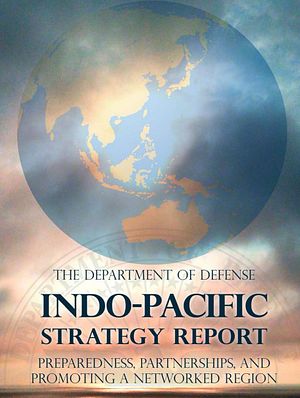It’s been a little more than one week since the release of the United States’ first-ever Indo-Pacific Strategy Report (IPSR), a strategic document prepared by the U.S. Department of Defense outlining Washington’s priorities in the region. The document (PDF) released online just minutes after U.S. Acting Secretary of Defense Patrick Shanahan took the podium in Singapore at this year’s Shangri-La Dialogue.
Curiously, Shanahan, who was expected to launch the document at the event, did not directly allude to it in his speech. Instead, he delivered a wide-ranging — and familiar — speech on security and defense topics pertaining to Asia. To repeat attendees of the dialogue, Shanahan’s speech evoked memories of the two speeches delivered by his predecessor, Jim Mattis, in 2018 and 2017 — or even those delivered by Ash Carter in the final years of the Obama administration.
The Indo-Pacific Strategy Report is the first document of its depth on the strategic megaregion referred to as the Indo-Pacific, which in the U.S. conception ranges from the western coast of India to the west coast of the United States. The “Indo-Pacific” concept has now been part of the U.S. policy repertoire since at least late-2017, when former U.S. Secretary of State Rex Tillerson leveraged the concept in a speech on U.S.-India relations.
The concept is distinct from Japan’s Indo-Pacific strategy and India’s conception of the Indo-Pacific as a geostrategic construct, but these three concepts overlap. Broadly, the Indo-Pacific concept inherits much of the groundwork laid by the Obama administration’s “pivot” or “rebalance” to Asia — with a several important differences. Reading the document, these differences become apparent and reflect more of the Trump administration’s perspective on Asian affairs.
First, and least surprisingly, the IPSR seizes on the 2017 National Security Strategy (NSS) and 2018 National Defense Strategy (NDS) documents’ descriptions of China as a strategic competitor. The document’s sections on “trends and challenges” in Asia begins with a bold headline declaring China a “revisionist power.” The Obama administration, ever keen to avoid outright confrontation or competition with China, avoided this, leaving competitive dynamics with Beijing on an implicit level. That the IPSR makes this a central theme is these least surprising component of the document.
Second, the document includes a focus on allies and, in particular, equitable burden-sharing with allies in the pursuit of Indo-Pacific security. Here, one of the themes of the late-Obama years of defense planning for Asia makes a reappearance in a new guise. The IPSR “affirms the enduring U.S. commitment to stability and prosperity in the region through the pursuit of preparedness, partnerships, and the promotion of a networked region” (emphasis added).
This follows in the footsteps of the 2016 articulation of a “principled security network” in Asia — a central theme of former Secretary of Defense Ash Carter’s speech at the Shangri-La Dialogue that year. The Trump administration extends this theme further by adding the flair that has been central in the president’s own messaging to allies; the IPSR notes that the “United States expects our allies and partners to shoulder a fair share of the burden of responsibility to protect against common threats.”
The document spends considerable attention on the initiative being taken by certain U.S. allies and partners in the Indo-Pacific project. Notably, page five alludes to high-level statements made in 2018 by officials from Japan, France, India, Australia, and New Zealand on the region, emphasizing the rules-based order. That a U.S. Department of Defense strategy document would draw this sort of attention to statements from other countries — even allies — is unusual, but in this case it serves a clear purpose: to signal demand for a status quo-preserving agenda in the region.
A somewhat surprising imbalance in the new IPSR is a lack of real focus on the Indian Ocean, which doesn’t receive as any particular attention outside of a subsection on partnerships in the region, focusing primarily on India and Sri Lanka. In particular, for observers in New Delhi, the IPSR may reaffirm concerns that the Indian Ocean Region (IOR) remains a tacked on component of what remains fundamentally a Pacific American orientation in the region. Insofar as the IOR is discussed, the IPSR makes clear that the U.S. will rely on partners — five specifically in the form of India, Sri Lanka, the Maldives, Bangladesh, and Nepal— — to tackle shared challenges in the area. This contrasts with the more forceful and ambitious language the report adopts on the rest of the Pacific region.
What the IPSR does more clearly than the previous strategy documents released by this administration is underscore its expectations for U.S. allies and partners and their contributions in the region — indeed, the IPSR provides a bullet point list on its very final page outlining expectations for allies and partners. In the end, there’s little inherently new in the IPSR. The document’s existence itself is curious. A close reader of the NSS and NDS would have been able to predict most of what finds itself in this new document.
Ultimately, whatever specific “Indo-Pacific” flair is found within the report is in the form of condensed fact sheets on U.S. diplomatic and security activities across the region. The report asserts in its opening line that the Indo-Pacific is the most “consequential region for America’s future,” but doesn’t seriously contend with how the United States is planning to ensure that limited resources will be allocated to match that assessment.
That’s where the Obama administration’s “rebalance” ultimately fell short: resources continued to be siphoned off by other priorities, mainly in Europe, the Middle East and North Africa. The Trump administration has yet to find itself unencumbered by challenges elsewhere. So if allies and partners like what they see in the IPSR, they’d do well to remember the pitfalls of promises without follow-up. There’s little sign that matters really are different this time, even if the IPSR is the most detailed U.S. strategy document of its kind on the Asian region in some time.

































